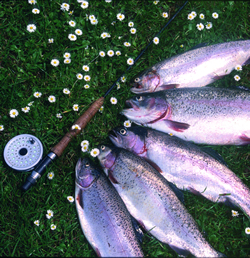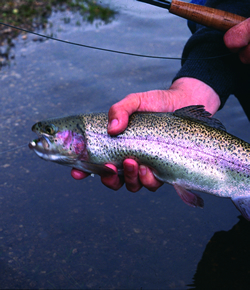You are here
A Limit of Twelve
Mike Weaver selects a dozen flies for trout on rivers and lakes
 When the editor of Get Hooked asked me to come up with a dozen trout flies for all waters – both rivers and lakes – my reaction was something between incredulity and panic. A quick look at a couple of my fly boxes revealed dozen of patterns and I am sure that I could have produced a good reason for including every one of them. But a closer look revealed that a much smaller number showed the wear and tear of frequent use, while perhaps the majority were still in a relatively pristine state. So, perhaps the range of flies that catch most of my trout is rather narrower than the contents of the fly boxes would at first suggest.
When the editor of Get Hooked asked me to come up with a dozen trout flies for all waters – both rivers and lakes – my reaction was something between incredulity and panic. A quick look at a couple of my fly boxes revealed dozen of patterns and I am sure that I could have produced a good reason for including every one of them. But a closer look revealed that a much smaller number showed the wear and tear of frequent use, while perhaps the majority were still in a relatively pristine state. So, perhaps the range of flies that catch most of my trout is rather narrower than the contents of the fly boxes would at first suggest.
Here then is a selection of 12 flies that season after season deliver the goods on all types of trout fisheries, starting with the rivers.
When the season opens, the streams are usually high and cold with little sign of rising trout, so it is necessary to get the fly down to the action area – and that means close to the riverbed. Nothing does this job better than a Goldhead Hare’s Ear Nymph, or perhaps a Goldhead Pheasant Tail Nymph. These are the deep-running versions of two of the most universal nymphs, and are also great fish catchers without the gold head when the trout are nearer the surface.
Once the trout start rising, you will need a fly to match the hatches of the ephemeroptera, the upwinged flies that increasingly answer to the collective name of mayflies, in this country as well as across the Atlantic. For 15 years my answer to this demand has been the Sparkle Dun and after many years when you had to tie your own, this pattern is increasingly available in tackle shops. It floats well thanks to the deer-hair wing, lasts for ever and catches fish – what more can you want?
The past decade has seen the rise and rise of the Klinkhamer, a wonderful dry fly that seems to lure fish just about anywhere at any time. It catches trout when they are rising to naturals but its great attribute is the way it brings fish to the surface when nothing is showing. And a few large Klinkhamers take care of your needs when there is a hatch of the real mayfly, ephemera danica.
From May until the end of the season you will need some sedges, or caddis flies. There are countless sedge patterns but my own preference is for those tied with a deer-hair wing and the widely-available Elk-Hair Caddis is one of the very best, whether fished with a dead drift or skated over the trout in the dying light of dusk.
From the first appearance of the true black gnat, bibio johannis, in May, there always seems to be small dark insects on the water throughout the summer, so make sure that you always have a Black Gnat in the fly box.
 The Grey Duster is a simple fly that can be used at any time, whether dry or wet – and its simplicity makes it the ideal pattern for anyone making a start with fly tying.
The Grey Duster is a simple fly that can be used at any time, whether dry or wet – and its simplicity makes it the ideal pattern for anyone making a start with fly tying.
Many anglers still use the traditional wet fly methods, both upstream and downstream. Whichever style you prefer, your fly selection should always include those two great Devon patterns, the Half Stone and the Blue Upright.
The most useful sizes for all of these river flies are 16 and 14, plus a few tiny Black Gnats in 18 or even 20 for low-water conditions. Although these are predominantly river patterns, I have taken plenty of lake trout on all of them, especially in larger sizes.
The final four flies are all primarily for lake trout, a tiny and arbitrary selection from the myriad patterns inspired by this branch of angling.
Throughout the year, still-water trout are caught with great regularity on various versions of the Damselfly Nymph, usually with a bit of weight, whether a gold head or a lead underbody. It is always useful to have a black fly in the box and one of the best is a Viva, whether large for stripping in with a sinking line or small for more delicate fishing neat the surface.
When lake trout are rising the chances are that they are taking some form of midge pupa, the most ubiquitous insect on most lakes, and then one of the buzzer patterns is needed, with a Black Buzzer usually a safe bet.
And finally, something for those days when nothing seems to be moving and the fishing is really tough – a Booby. Tie a Booby to about 18 inches of leader attached to a sinking line, retrieve it slowly with the buoyant fly riding just above the bottom and wait for the action. Rather crude but very effective.
